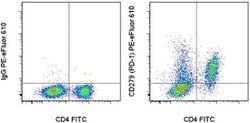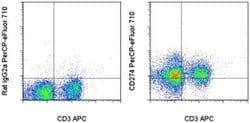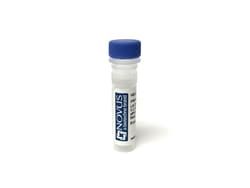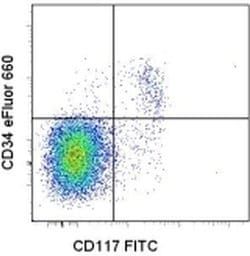7092300
CD279 (PD-1) Monoclonal Antibody (J43), eFluor™ 450, eBioscience™, Invitrogen™
Armenian Hamster Monoclonal Antibody
Manufacturer: Fischer Scientific
The price for this product is unavailable. Please request a quote
Antigen
CD279 (PD-1)
Concentration
0.2 mg/mL
Classification
Monoclonal
Form
Liquid
Regulatory Status
RUO
Formulation
PBS with 0.09% sodium azide; pH 7.2
Gene Alias
CD279; EGK_05005; hPD1; hPD-1; hPD-l; hSLE1; Ly101; mPD-1; PD1; PD-1; Pdc1; Pdcd1; programmed cell death 1; programmed cell death 1 protein; programmed cell death protein 1; programmed cell death protein 1-like; programmed death 1; Protein PD1; protein PD-1; sCD279; SLEB2; soluble CD279; systemic lupus erythematosus susceptibility 2
Gene Symbols
Pdcd1
Primary or Secondary
Primary
Content And Storage
4° C, store in dark, DO NOT FREEZE!
Gene
Pdcd1
Clone
J43
Applications
Flow Cytometry
Conjugate
eFluor 450
Host Species
Armenian Hamster
Target Species
Mouse
Gene Accession No.
Q02242
Gene ID (Entrez)
18566
Isotype
IgG
Purification Method
Affinity chromatography
Product Type
Antibody
Description
- Description: The J43 monoclonal antibody reacts with mouse PD-1 (programmed death-1), a 55 kDa member of the Ig superfamily
- PD-1 contains the immunoreceptor tyrosine-based inhibitory motif (ITIM) and plays a key role in peripheral tolerance and autoimmune disease in mice
- PD-1 is expressed mainly on activated T and B lymphocytes
- Two novel B7 Family members have been identified as PD-1 ligands, PD-L1 (B7-H1) and PD-L2 (B7-DC)
- Evidence reported to date suggests overlapping functions for these ligands and their constitutive expression on some normal tissues and upregulation on activated antigen-presenting cells
- It is reported that J43 inhibits the binding of mouse PD-L1-Ig and mouse PD-L2-Ig to PD-1/BHK transfected cells
- When administrated in vivo, both intact and Fab of J43 are reported to enhance contact hypersensitivity and exacerbate acute GVHD similar to transfer of PD-1-deficient cells
- Injection of J43 also exacerbates EAE and NOD diabetes as do specific antibodies to mouse PD-L1 and PD-L2
- Applications Reported: This J43 antibody has been reported for use in flow cytometric analysis
- Applications Tested: This J43 antibody has been tested by flow cytometric analysis of stimulated mouse splenocytes
- This can be used at less than or equal to 0.5 μg per test
- A test is defined as the amount (μg) of antibody that will stain a cell sample in a final volume of 100 μL
- Cell-mediated immune responses are initiated by T lymphocytes that are themselves stimulated by cognate peptides bound to MHC molecules on antig en-presenting cells (APC)
- T-cell activation is generally self-limited as activated T cells express receptors such as PD-1 (also known as PDCD-1) that mediate inhibitory signals from the APC
- PD-1 can bind two different but related ligands, PDL-1 and PDL-2
- Upon binding to either of these ligands, signals generated by PD-1 inhibit the activation of the immune response in the absence of "edanger signals"e such as LPS or other molecules associated with bacteria or other pathogens
- Evidence for this is seen in PD1-null mice who exhibit hyperactivated immune systems and autoimmune diseases
- Despite its predicted molecular weight, PD-1 often migrates at higher molecular weight in SDS-PAGE.
Compare Similar Items
Show Difference
Antigen: CD279 (PD-1)
Concentration: 0.2 mg/mL
Classification: Monoclonal
Form: Liquid
Regulatory Status: RUO
Formulation: PBS with 0.09% sodium azide; pH 7.2
Gene Alias: CD279; EGK_05005; hPD1; hPD-1; hPD-l; hSLE1; Ly101; mPD-1; PD1; PD-1; Pdc1; Pdcd1; programmed cell death 1; programmed cell death 1 protein; programmed cell death protein 1; programmed cell death protein 1-like; programmed death 1; Protein PD1; protein PD-1; sCD279; SLEB2; soluble CD279; systemic lupus erythematosus susceptibility 2
Gene Symbols: Pdcd1
Primary or Secondary: Primary
Content And Storage: 4° C, store in dark, DO NOT FREEZE!
Gene: Pdcd1
Clone: J43
Applications: Flow Cytometry
Conjugate: eFluor 450
Host Species: Armenian Hamster
Target Species: Mouse
Gene Accession No.: Q02242
Gene ID (Entrez): 18566
Isotype: IgG
Purification Method: Affinity chromatography
Product Type: Antibody
Antigen:
CD279 (PD-1)
Concentration:
0.2 mg/mL
Classification:
Monoclonal
Form:
Liquid
Regulatory Status:
RUO
Formulation:
PBS with 0.09% sodium azide; pH 7.2
Gene Alias:
CD279; EGK_05005; hPD1; hPD-1; hPD-l; hSLE1; Ly101; mPD-1; PD1; PD-1; Pdc1; Pdcd1; programmed cell death 1; programmed cell death 1 protein; programmed cell death protein 1; programmed cell death protein 1-like; programmed death 1; Protein PD1; protein PD-1; sCD279; SLEB2; soluble CD279; systemic lupus erythematosus susceptibility 2
Gene Symbols:
Pdcd1
Primary or Secondary:
Primary
Content And Storage:
4° C, store in dark, DO NOT FREEZE!
Gene:
Pdcd1
Clone:
J43
Applications:
Flow Cytometry
Conjugate:
eFluor 450
Host Species:
Armenian Hamster
Target Species:
Mouse
Gene Accession No.:
Q02242
Gene ID (Entrez):
18566
Isotype:
IgG
Purification Method:
Affinity chromatography
Product Type:
Antibody
Antigen: CD34
Concentration: 0.2 mg/mL
Classification: Monoclonal
Form: Liquid
Regulatory Status: RUO
Formulation: PBS with 0.09% sodium azide; pH 7.2
Gene Alias: (E3-independent) E2 ubiquitin-conjugating enzyme R1; AU040960; CD34; CD34 antigen; CD34 molecule; CDC34; cell division cycle 34; cell division cycle 34 homolog; cluster designation 34; cluster of differentiation antigen 34; E2 ubiquitin-conjugating enzyme R1; E2-CDC34; hematopoietic progenitor cell antigen CD34; hematopoietic progenitor cell marker CD34; Mucosialin; RP11-328D5.2; sialomucin protein; type 1 transmembrane protein; UBC3; UBCH3; UBE2R1; ubiquitin carrier protein; ubiquitin conjugating enzyme E2 R1; ubiquitin-conjugating enzyme E2 R1; Ubiquitin-conjugating enzyme E2-32 kDa complementing; ubiquitin-conjugating enzyme E2-CDC34; Ubiquitin-protein ligase R1
Gene Symbols: Cd34
Primary or Secondary: Primary
Content And Storage: 4° C, store in dark, DO NOT FREEZE!
Gene: Cd34
Clone: RAM34
Applications: Flow Cytometry
Conjugate: eFluor 660
Host Species: Rat
Target Species: Mouse
Gene Accession No.: Q64314
Gene ID (Entrez): 12490
Isotype: IgG2a κ
Purification Method: Affinity chromatography
Product Type: Antibody
Antigen:
CD34
Concentration:
0.2 mg/mL
Classification:
Monoclonal
Form:
Liquid
Regulatory Status:
RUO
Formulation:
PBS with 0.09% sodium azide; pH 7.2
Gene Alias:
(E3-independent) E2 ubiquitin-conjugating enzyme R1; AU040960; CD34; CD34 antigen; CD34 molecule; CDC34; cell division cycle 34; cell division cycle 34 homolog; cluster designation 34; cluster of differentiation antigen 34; E2 ubiquitin-conjugating enzyme R1; E2-CDC34; hematopoietic progenitor cell antigen CD34; hematopoietic progenitor cell marker CD34; Mucosialin; RP11-328D5.2; sialomucin protein; type 1 transmembrane protein; UBC3; UBCH3; UBE2R1; ubiquitin carrier protein; ubiquitin conjugating enzyme E2 R1; ubiquitin-conjugating enzyme E2 R1; Ubiquitin-conjugating enzyme E2-32 kDa complementing; ubiquitin-conjugating enzyme E2-CDC34; Ubiquitin-protein ligase R1
Gene Symbols:
Cd34
Primary or Secondary:
Primary
Content And Storage:
4° C, store in dark, DO NOT FREEZE!
Gene:
Cd34
Clone:
RAM34
Applications:
Flow Cytometry
Conjugate:
eFluor 660
Host Species:
Rat
Target Species:
Mouse
Gene Accession No.:
Q64314
Gene ID (Entrez):
12490
Isotype:
IgG2a κ
Purification Method:
Affinity chromatography
Product Type:
Antibody
Antigen: Rat IgG2a kappa
Concentration: 0.2 mg/mL
Classification: __
Form: Liquid
Regulatory Status: RUO
Formulation: PBS with 0.09% sodium azide; pH 7.2
Gene Alias: IgG2; Immunoglobulin G; Immunoglobulin G2; ImmunoglobulinG; ImmunoglobulinG2
Gene Symbols: __
Primary or Secondary: Isotype Control (Primary)
Content And Storage: 4° C, store in dark, DO NOT FREEZE!
Gene: __
Clone: eBR2a
Applications: Control, Flow Cytometry, Immunocytochemistry, Immunohistochemistry, Immunohistochemistry
Conjugate: eFluor 660
Host Species: Rat
Target Species: Not Applicable
Gene Accession No.: __
Gene ID (Entrez): __
Isotype: IgG2a κ
Purification Method: Affinity chromatography
Product Type: __
Antigen:
Rat IgG2a kappa
Concentration:
0.2 mg/mL
Classification:
__
Form:
Liquid
Regulatory Status:
RUO
Formulation:
PBS with 0.09% sodium azide; pH 7.2
Gene Alias:
IgG2; Immunoglobulin G; Immunoglobulin G2; ImmunoglobulinG; ImmunoglobulinG2
Gene Symbols:
__
Primary or Secondary:
Isotype Control (Primary)
Content And Storage:
4° C, store in dark, DO NOT FREEZE!
Gene:
__
Clone:
eBR2a
Applications:
Control, Flow Cytometry, Immunocytochemistry, Immunohistochemistry, Immunohistochemistry
Conjugate:
eFluor 660
Host Species:
Rat
Target Species:
Not Applicable
Gene Accession No.:
__
Gene ID (Entrez):
__
Isotype:
IgG2a κ
Purification Method:
Affinity chromatography
Product Type:
__
Antigen: Mouse IgG1 kappa
Concentration: 0.2 mg/mL
Classification: __
Form: Liquid
Regulatory Status: RUO
Formulation: PBS with 0.09% sodium azide; pH 7.2
Gene Alias: IgG1; Igh-4; Ighg1; Immunoglobulin G; Immunoglobulin G1; immunoglobulin heavy constant gamma 1 (G1m marker); ImmunoglobulinG; ImmunoglobulinG1; VH7183
Gene Symbols: __
Primary or Secondary: Isotype Control (Primary)
Content And Storage: 4° C, store in dark, DO NOT FREEZE!
Gene: __
Clone: P3.6.2.8.1
Applications: Control, Flow Cytometry, Immunohistochemistry
Conjugate: eFluor 660
Host Species: Mouse
Target Species: Not Applicable
Gene Accession No.: __
Gene ID (Entrez): __
Isotype: IgG1 κ
Purification Method: Affinity chromatography
Product Type: __
Antigen:
Mouse IgG1 kappa
Concentration:
0.2 mg/mL
Classification:
__
Form:
Liquid
Regulatory Status:
RUO
Formulation:
PBS with 0.09% sodium azide; pH 7.2
Gene Alias:
IgG1; Igh-4; Ighg1; Immunoglobulin G; Immunoglobulin G1; immunoglobulin heavy constant gamma 1 (G1m marker); ImmunoglobulinG; ImmunoglobulinG1; VH7183
Gene Symbols:
__
Primary or Secondary:
Isotype Control (Primary)
Content And Storage:
4° C, store in dark, DO NOT FREEZE!
Gene:
__
Clone:
P3.6.2.8.1
Applications:
Control, Flow Cytometry, Immunohistochemistry
Conjugate:
eFluor 660
Host Species:
Mouse
Target Species:
Not Applicable
Gene Accession No.:
__
Gene ID (Entrez):
__
Isotype:
IgG1 κ
Purification Method:
Affinity chromatography
Product Type:
__








